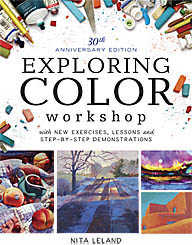Mixing earth colors
When I first started painting in watercolors I read all of the popular books of the time by such noted artists as Rex Brandt, Herb Olsen, John Pike, Edgar Whitney and many others. I kept notes on the artists' palettes and eventually discovered that there were certain "workhorse" colors that appeared on nearly every palette. French ultramarine, burnt umber, alizarin crimson, cadmium yellow and yellow ochre were the most common. The next tier included Prussian blue, burnt sienna, raw sienna, sepia, cadmium red, brown madder alizarin and Hooker's green. My own palette grew exponentially until there simply wasn't enough room for all the colors the experts recommended.
Fortunately, about that time I began to get a sense of what my own preferences were and the first colors to depart my palette were the earth colors. Why? Because I found I could mix them so easily starting from primary and secondary colors. I found I could make Payne's gray and burnt umber with French ultramarine and burnt sienna. Then I discovered that burnt sienna makes a lovely earth mixture with every other color on my palette. (Note: I use only Winsor & Newton Burnt Sienna.) I also found that by mixing complements (opposites), on the way to achieving neutral mixtures there is a range of earth mixtures that is nothing short of stunning.
So now I don't keep earth colors on my palette, unless I have a specific need for them in a painting.* To me the mixtures are far more beautiful. If I don't mix too much, I can achieve variations of every earth hue that add to the color excitement in a painting. That's the way I like it.
*More on this in another blog.
Fortunately, about that time I began to get a sense of what my own preferences were and the first colors to depart my palette were the earth colors. Why? Because I found I could mix them so easily starting from primary and secondary colors. I found I could make Payne's gray and burnt umber with French ultramarine and burnt sienna. Then I discovered that burnt sienna makes a lovely earth mixture with every other color on my palette. (Note: I use only Winsor & Newton Burnt Sienna.) I also found that by mixing complements (opposites), on the way to achieving neutral mixtures there is a range of earth mixtures that is nothing short of stunning.
So now I don't keep earth colors on my palette, unless I have a specific need for them in a painting.* To me the mixtures are far more beautiful. If I don't mix too much, I can achieve variations of every earth hue that add to the color excitement in a painting. That's the way I like it.
*More on this in another blog.
Labels: color, color mixing, green, tutorials, watercolor





0 Comments:
Post a Comment
<< Home